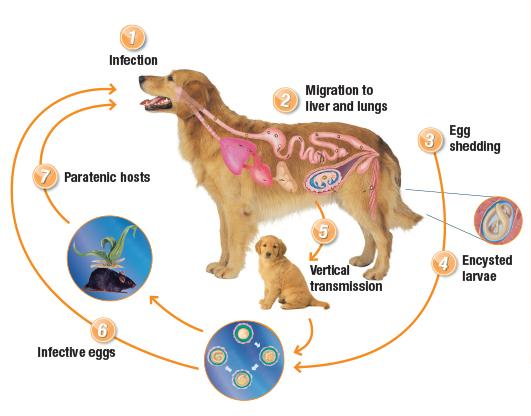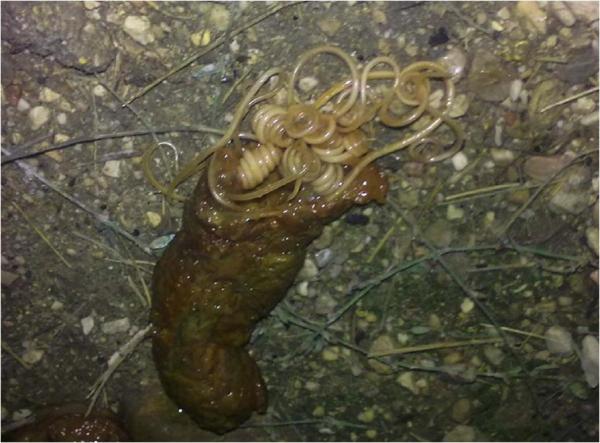
Toxocara canis is one of the most common parasites in dogs. Referred to also as roundworm, this heminth parasite can affect all canidae species and humans alike. Toxocara canis is zooonosis, meaning that it can be transmitted from animals to humans. This is why it is incredibly important to follow your dog’s deworming calendar and make sure you keep up to date with necessary veterinary checkups.
For more about the toxocara canis life cycle, the symptoms it causes in dogs and necessary toxocara canis treatment, keep reading here at AnimalWised.
Toxocariasis: what is it?
Toxocara canis (or toxocariasis in dogs) is a parasitic worm that is located in a dog's stomach and intestines. Here, this roundworm can reach considerable almost 20 centimeters in length. Female roundworms can also sometimes release a large amount of resistant eggs into this environment where the eggs can survive for years.
Dogs can become infected with roundworm during the prenatal period, i.e: pregnancy of a dog. But, it is also common that a dog may become infected with toxocariasis through drinking breast milk (containing roundworm eggs), or alternatively, by ingesting infested prey.
The biological toxocara canis life cycle begins when the eggs reach the stomach. Through blood circulation, the larvae moves to the lungs and, from there, reaches the trachea and are ingested again. Once back in the stomach, these larvae are transformed into adult worms ready to lay eggs that are are already capable of infecting other animals, thus restarting the cycle.

Toxocara Canis: symptoms
As dogs grow they develop resistance to toxocara canis, which helps to prevent many of these parasites from completing their biological cycle. However, sometimes, these larvae encyst in different parts of the body and activate in bitches, specifically during gestation periods. Here, these roundworms then migrate to the placenta and mammary glands.
Toxocara canis does not usually cause any apparent symptoms in adult dogs. However, toxocara canis symptoms in puppies are visible as:
- Intermittent vomiting and diarrhea.
- Visible worms in expulsion (looks like spaghetti)
Serious toxacara canis symptoms in puppies may include:
- Puppies won’t grow correctly or efficiently.
- Puppies will appear pare.
- Swollen abdomen.
- Pain on palpation.
- Anemia.
- Larvae in the lungs can cause coughing and nausea.

Toxocara Canis: diagnosis
Observation of parasites in a dog’s feces is a direct diagnostic method. You can also take a stool sample to a veterinarian who can then examine the stool under a microscope, allowing for correct identification of taxocara canis eggs. If any of these above symptoms are noticed, immediate veterinary treatment is necessary.
For more, we recommend reading:
- Deworming my pregnant dog.
- Deworming dogs: preventing and treating parasites.
Toxocara canis: treatment
Toxocara canis in dogs treatment must be prescribed by a veterinarian, since only a professional can identify the parasite. There are several drugs on the market which fight against toxocara canis. A veterinarian will be the one to choose the most appropriate treatment according to your dog’s specific case, gender, breed and age. It is important to look for a product that also eliminates the encysted larvae, such as milbemax.
The best way to fight and avoid internal parasites is through prevention. Establishing a proper deworming calendar that should begin at fifteen days of age in necessary. This treatment should be repeated every two weeks until the end of your puppy’s vaccination schedule. In addition, it should be maintained every 3-4 months throughout your dog's life.
We recommend deworming your pregnant dog two weeks prior to the approximate date of delivery and during lactation. This should decreases the parasitic load of the environment and reduce chances of puppy infestation.
For more about how to recognize if your dog has worms, we recommend reading our article about the: types of dog poop and what they mean.
Toxocara canis in humans
Toxocara canis is zoonotic, which means it can be transmitted to humans from dogs. Toxocara canis causes a disease in humans called visceral larva migrans. This infection occurs due to an ingestion of the parasitic eggs. Therefore, children who eat dirt and have deficiency in hygiene habits, are more at risk.
Spaces shared by dogs and children, such as parks, can become pockets of contamination. In this sense, it is essential to always pick up and throw away your canine’s excrement. Toxocara canis life cycle in humans is different than that in dogs, as larvae in humans are unable to reach adulthood. Instead, visceral larva migrans in humans cross the intestinal wall and migrate to the liver, lungs and skin.
When largely infested, toxocariasis symptoms in humans include:
- Abdominal pain.
- Coughing.
- Itching or rash.
- Larvae can spread to the heart, kidneys, spleen, brain or eyes.
Prevention in humans involves keeping animals properly dewormed, especially puppies and pregnant bitches. This is in addition to educating children about basic hygiene habits.

This article is purely informative. AnimalWised does not have the authority to prescribe any veterinary treatment or create a diagnosis. We invite you to take your pet to the veterinarian if they are suffering from any condition or pain.
If you want to read similar articles to Toxocara Canis In Dogs - Causes, Symptoms, Diagnosis and Treatment, we recommend you visit our Parasitic diseases category.